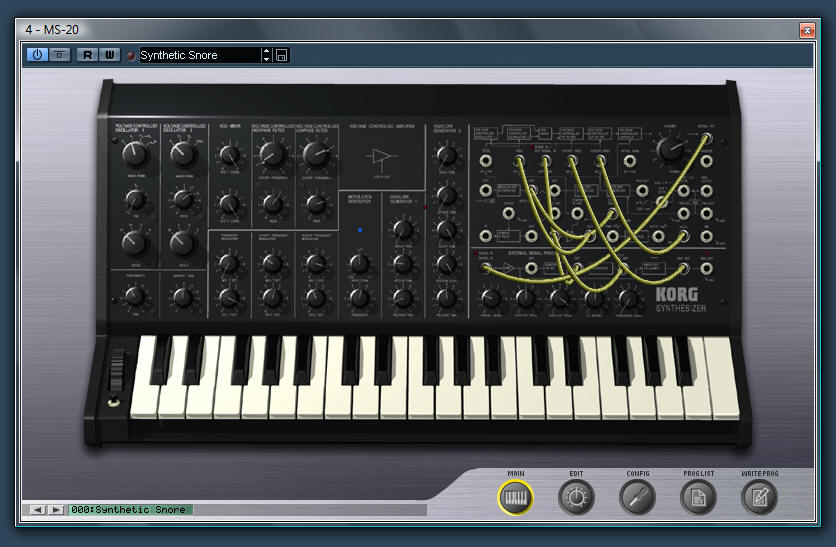Korg M1 Mac Serial Port
Oct 03, 2017 Mix - VST Plugins - KORG M1 Le v1.1 WIN & OSX Full - Free Download YouTube Programming in Visual Basic.Net How to Connect Access Database to VB.Net - Duration: 19:11. IBasskung 20,532,977 views. Mix - VST Plugins - KORG M1 Le v1.1 WIN & OSX Full - Free Download YouTube Les Paul Style Guitar Timelapse Build - Duration: 23:41. Dan Strack 5,706,850 views.
Could someone please help me get started with my setup? It's pretty basic - but I'm new and learning...
I have a Korg M1 (want to use as controller)
Emu Proteus 1
MOTU Ultralite mk3
Macbook Pro
Glyph external drive with firewire
Here is the setup:
Hardware:
Glyph fw800 -> Macbook Pro fw800
MOTU Ultralite fw400 -> Glyph fw400
Korg M1 midi in/out ->MOTU midi in/out
Korg M1 midi thru -> Proteus 1 midi thru
M1 'midi global' local control off
clock: external
Channel:1
Proteus 1: Multi mode
Software:
Macbook Pro:
System prefs -> Sound -> Input/Output are set to MOTU Ultralite
Macbook Pro -> applications -> utilities -> audio midi setup -> default input/default output and system output are set to MOTU Ultralite
(the audio midi setup -> midi devices, I added the korg m1 and the proteus and connected lines to the in/out on the motu ultralite icon
When you doubleclick on the korg m1 device, it has 2 tabs for properties / ports set up. For the properties tab - Do I highlight the first 8 'transmits/receives' channel buttons for the m1 and then highlight all 16 for the proteus? For the ports tab, Port 1, connectors for port 1: midi in '1' midi out '1' ?
I'm lost with the logic setup. Please advise. I'm hearing nothing when I play a song I had started on a different setup.
Also, I have an MOTU microlite midi box (5 inputs/outputs) - would it be easier to hook this into the chain and how would I do that?
Thank you so much for your help in advance.
MacBook Pro, Mac OS X (10.5.6)
Posted on
| M1 | |
|---|---|
| Manufacturer | Korg |
| Dates | 1988–1995 |
| Price | $2,166 US £1,499 GBP ¥248,000 JPY |
| Technical specifications | |
| Polyphony | 16 voices |
| Timbrality | 8 part |
| Oscillator | 16 bit 2MWord (4MB) PCM waveform ROM (100 multisounds + 44 drum sounds)[1] |
| Synthesis type | |
| Filter | VDF (Variable Digital Filter), low-pass velocity sensitive (non-resonant) |
| Attenuator | 3 independent AADBSSRR[2] envelope generators |
| Aftertouch expression | Yes |
| Velocity expression | Yes |
| Storage memory | 100 programs / 100 combinations / 4400 sequencer notes or 50 programs / 50 combinations / 7700 sequencer notes depending on global settings, and 10 songs + 100 patterns[3] |
| Effects | Reverb, delay, phaser, tremolo, exciter, ensemble, overdrive, EQ, chorus, flanger, rotary speaker |
| Input/output | |
| Keyboard | 61 keys |
| Left-hand control | Spring-return joystick (pitch and modulation) |
| External control | MIDI IN/OUT/THRU |
The Korg M1 is a synthesizer and music workstation manufactured by Korg from 1988 to 1995. It became the top-selling digital synthesizer of its time.[4]
Development[edit]
Whereas previous synthesizers had shipped with sounds chosen for different markets, Korg chairman Tsutomu Kato and his son Seiki decided that their synthesizers should use the same sounds internationally. Korg assembled an international team to develop the sounds for the M1. To create a deep blown bottle sound, the team played a pan flute over a large sake bottle.[5]
Features[edit]
The M1 features a 61-note velocity- and aftertouch-sensitive keyboard, 16-note polyphony, a joystick for pitch-bend and modulation control, an eight-track MIDI sequencer, separate LFOs for vibrato and filter modulation, and ADSR envelopes.[5] Data can be stored on RAM and PCM cards.[5]
The M1 has a ROM with four megabytes of 16-bit PCM tones, including, according to Sound on Sound, 'exotic instruments that previously hadn't been heard in the mainstream'.[5] The sounds include sampled attack transients, loops, sustained waveforms without attack transients, and percussive samples. The timbres include piano, strings, acoustic guitar, woodwinds, sitar, kalimba, wind chimes, and drums.[5]
It also features effects including reverb, delay, chorus, tremolo, EQ, distortion, and Leslie simulation, an innovative inclusion at the time.[5] According to Sound on Sound, none of the M1's features were unique at the time of release, but were implemented and combined in a new way.[5]
Legacy[edit]
The Korg M1 is the bestselling synthesizer in history.[5] It was released in 1988 and manufactured until 1995, selling an estimated 250,000 units.[5]Sound on Sound wrote that it 'can rightly be called the most popular synth of all time'.[5]
The M1 piano and organ presets were widely used in 1990s house music, beginning with Madonna's 1990 single 'Vogue'.[6] Its slap bass sound was used to create the theme tune for the sitcom Seinfeld.[6]
References[edit]
- ^Korg M1 Super Guide, The Next Generation in Sound Synthesis --- The AI Synthesis System, p13, Multisound List, Korg Inc. Japan
- ^Korg M1 Super Guide, The Next Generation in Sound Synthesis --- The AI Synthesis System, p14, VDF EG, Korg Inc. Japan
- ^Korg M1 Super Guide, The Next Generation in Sound Synthesis --- The AI Synthesis System, p44, Specifications, Korg Inc. Japan
- ^Colbeck, Julian (June 2001). 'Korg M1'. Electronic Musician. Archived from the original on 23 Sep 2004.
- ^ abcdefghij'Korg M1 (Retrozone)'. www.soundonsound.com. Retrieved 2019-04-28.
- ^ ab'A Beginner's Guide To The Synth'. Gizmodo Australia. 2015-12-29. Retrieved 2019-04-28.
Korg M1 Mac Serial Port To Usb Cable

Further reading[edit]
- 'Life In The Fast Lane'. Sound On Sound. August 1988. pp. 40–46. ISSN0951-6816. OCLC925234032.